#lundehund breed compendium
Explore tagged Tumblr posts
Text
Utilization: By his anatomical peculiarities this dog is predestinated to puffin-hunting on the steep rocks around the fjords and along the shore.

The standard:
Neck: Clean-cut, of medium length, quite strong with a relatively well furnished collar.
Compendium comment:
The head is carried relatively low. The two last vertebrae (atlas/apsis) are shaped so that the dog can bend backwards so that the head touches the back. To do so is vital when turning in the narrow burrows. NB! This should NEVER be demonstrated the ring!
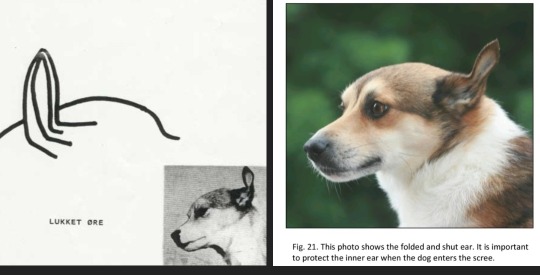
The standard:
Ears: Triangular ears of medium size, broad at the base, carried erect and very mobile. The cartilage of the ear lobe has the faculty of being able to retract itself so that the ear folds itself and flops in a specific manner, either backwards or in right angle upwards, so as to close the auditory passage.
Compendium addition:
The ears of the Lundehund have a unique muscle that enables them to fold and close the ears when entering the burrows, thus protecting them against dirt and moisture. The turning and folding of the ears probably also is help in locating the birds.
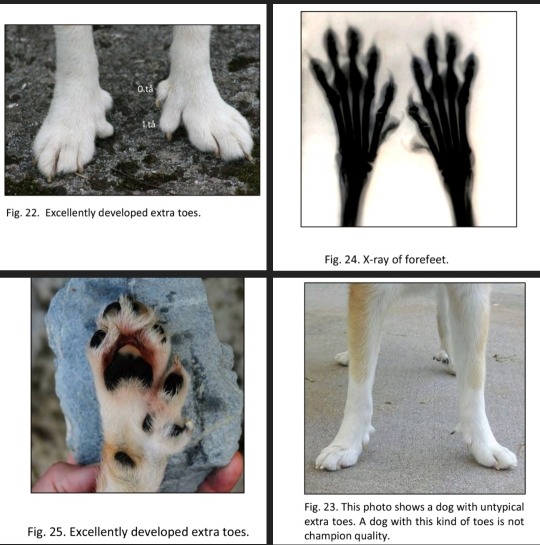
The standard:
Forelimbs: Moderately angulated. Forearm: Straight.
Forefeet: Oval shaped, turning slightly outwards, with at least six toes of which five must rest on the ground. Eight pads on each foot. The two inner toes, formed respectively by 3 and 2 phalanges and endowed with a ligamentary and muscular system, make the foot look solid.
Compendium addition:
Very flexible and elastic shoulder muscles. The Lundehund has joints that allow the forelimbs to extend at nearly 90 degrees from the body, but this must NEVER be demonstrated in the ring! The forefeet turn slightly outwards to give room for the extra toes.
The Norwegian Lundehund is a polydactyl. Instead of the normal 4 digits, the Lundehund normally has 6 digits, all fully formed, jointed and muscled, with tendons going up the inside of the leg, partly responsible for its wide front gait. Some specimen may have more, others less than 6 digits per foot, but less than 6 on front feet should lead to downgrading. The extra toes help the dog climbing up and down crevices in screes and cliffs.
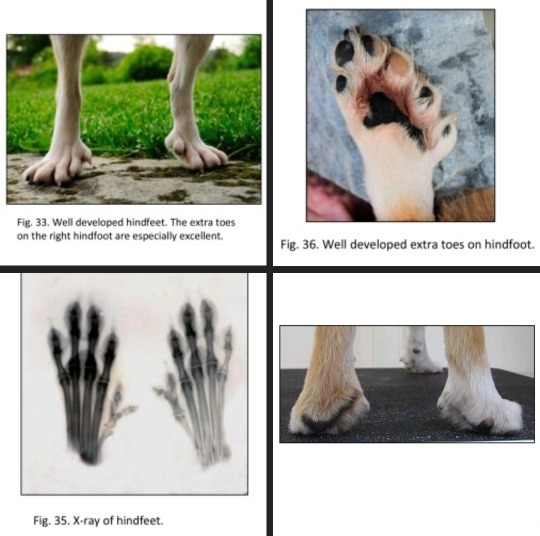
The standard:
Hindfeet : Oval shaped, turned slightly outwards, with at least six toes - four of which must rest on the ground. Seven pads on each foot, the one in the middle, the most important one by its size, being attached to the inner pads corresponding to the two inner toes. When the dog is standing up on a flat surface, the weight of the body must be evenly distributed on the pads.
Compendium comment:
More than 6 digits is not a fault. 5 digits are acceptable on the hind feet. The extra toes on the hind feet are normally less developed than those on the forelegs and variations from the ideal, both regarding number and placement, should not be penalized.
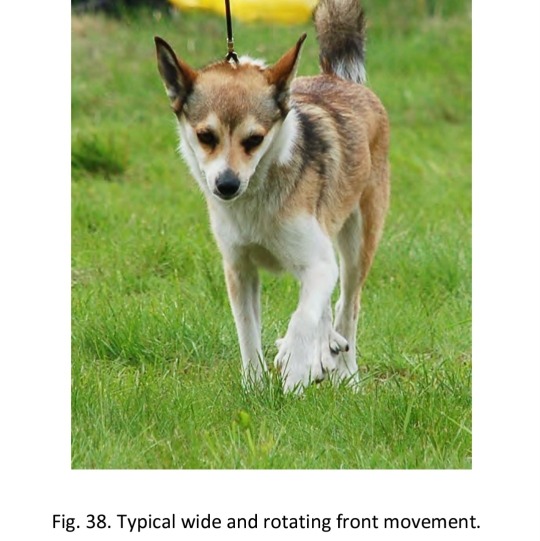
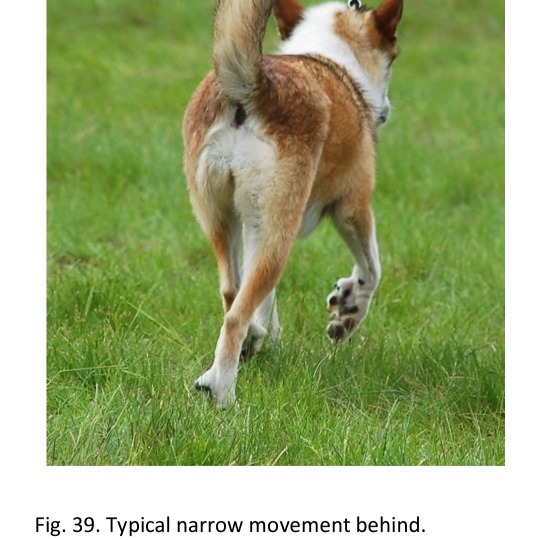
The standard:
Gait/Movement: Light and elastic. An external rotary action of the forelegs and somewhat close action behind is characteristic of the breed.
Compendium comment:
In judging the movements of the Lundehund, one must consider that this dog is built to climb efficiently up and down steep cliffs and screes. The extra pads on both fore- and hind paws must then touch the surface to aid the dog in climbing. The extra toes help getting a grip, both in ascent and descent. The wide front with extra flexibility enables climbing safely up and down crevices, as the forelegs can grip at a 90 degrees angle to the body. On flat surfaces, the Lundehund will show typical rotating front movements, due to tendons and muscles from the extra digits on the inside of the legs. Hind movements are narrow.
#norwegian lundehund#lundehund breed compendium#(excerpts)#photos from the compendium + the top from a veterinary journal on outcrossing#is2g every time i talk about this breed it sounds like youre making a fantasy species thats a Dog But Slightly Off#long post#some of these traits appear in other primitive breeds as well#lundehunds were described in 17th and 18th century texts. but we know there have been dogs in this area for thousands of years#plently long enough to produce a freak of nature (<3)
995 notes
·
View notes
Note
I was reading through posts on the Lundehund after the recent news and was wondering, why are characteristics like the closing ears and weird shoulders never to be demonstrated in the show ring? The legs I get since that’s just not nice for the dog but the ears? And how do you confirm that the dog follows the breed standard if it’s not demonstrated?
The traits noted in the breed compendium to not be demonstrated in the ring are the 90 degree extension of the front limbs and the bending of the neck. For context, these ones:

It's because these are extremes. It's one thing for the dog to do it naturally, by themselves and under their own control - or even by a trusted person in a calm environment. In a foreign, hectic environment, maybe handled by strangers, it could cause injury.
(The 'typical Lundehund temperament' also doesn't, uh. Lend itself to compliant demonstration. This is why we watch dog shows and joke that 'the Lundehund enters the ring, waiting for the handler to look away so it can f*ck off back home. 10/10 standard compliance!')
The closing of the ears doesn't have a do-not-demonstrate in the guidelines, so I suppose it could be demonstrated. Probably by asking it to please behave like a normal dog, or something like that.
As for confirming that the dog is bred to standard - that's ultimately the breeder's job. Every breed has required traits that won't be properly demonstrated in a show ring, or traits that can be played up for the occasion. Lundehunds are rare and breeders are an exclusive group, they've fought tooth and nail for many decades to keep this breed as special and true (read: fucking bizarre) as its environment and purpose have made it. So when a project dog gets entered into the studbook, I expect two things: 1) This is a dog they have faith in and that checks all the boxes and 2) if it didn't Do The Things that make a Lundehund a Lundehund, they'd be publicly executed.
#i think its maybe hard sometimes#even just for those of us in other breeds#to recognize how collaborative lundehund people are#not just breeders but owners. every other year the club tracks down the owner of every single living dog for health surveys#in 2024 that was 1125 dogs in norway. 5 owners ignored it. 2 rejected it. in the end the survey was completed for 1071 dogs - 95%#imagine in what other scenario you get a response rate of 95% when sending out a digital survey by email#these people dont even TRY to be normal about their breed.#+ frankly with the project dogs in particular. they've been shown and accepted by expert judges who in all likelihood Know Who This Dog Is#the guy who registered the first two led the project for many years
42 notes
·
View notes